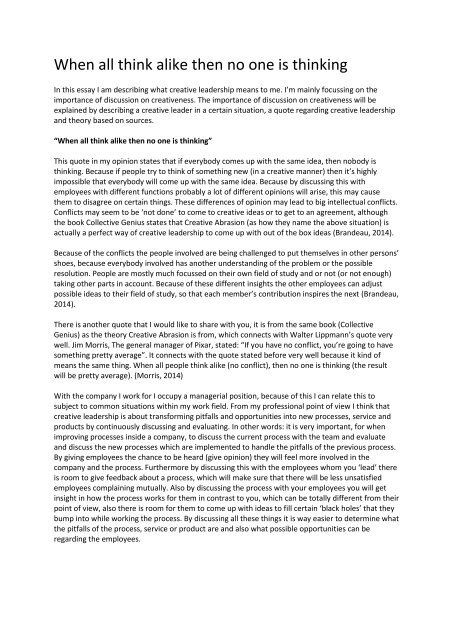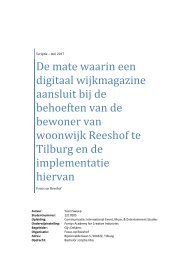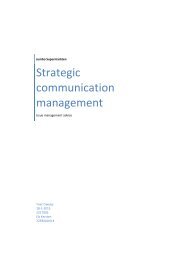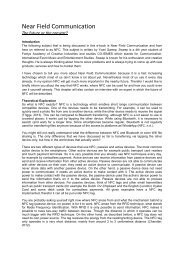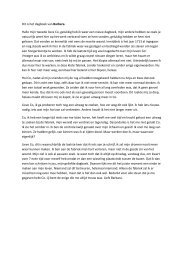AC Leadership
You also want an ePaper? Increase the reach of your titles
YUMPU automatically turns print PDFs into web optimized ePapers that Google loves.
When all think alike then no one is thinking<br />
In this essay I am describing what creative leadership means to me. I’m mainly focussing on the<br />
importance of discussion on creativeness. The importance of discussion on creativeness will be<br />
explained by describing a creative leader in a certain situation, a quote regarding creative leadership<br />
and theory based on sources.<br />
“When all think alike then no one is thinking”<br />
This quote in my opinion states that if everybody comes up with the same idea, then nobody is<br />
thinking. Because if people try to think of something new (in a creative manner) then it’s highly<br />
impossible that everybody will come up with the same idea. Because by discussing this with<br />
employees with different functions probably a lot of different opinions will arise, this may cause<br />
them to disagree on certain things. These differences of opinion may lead to big intellectual conflicts.<br />
Conflicts may seem to be ‘not done’ to come to creative ideas or to get to an agreement, although<br />
the book Collective Genius states that Creative Abrasion (as how they name the above situation) is<br />
actually a perfect way of creative leadership to come up with out of the box ideas (Brandeau, 2014).<br />
Because of the conflicts the people involved are being challenged to put themselves in other persons’<br />
shoes, because everybody involved has another understanding of the problem or the possible<br />
resolution. People are mostly much focussed on their own field of study and or not (or not enough)<br />
taking other parts in account. Because of these different insights the other employees can adjust<br />
possible ideas to their field of study, so that each member’s contribution inspires the next (Brandeau,<br />
2014).<br />
There is another quote that I would like to share with you, it is from the same book (Collective<br />
Genius) as the theory Creative Abrasion is from, which connects with Walter Lippmann’s quote very<br />
well. Jim Morris, The general manager of Pixar, stated: “If you have no conflict, you’re going to have<br />
something pretty average”. It connects with the quote stated before very well because it kind of<br />
means the same thing. When all people think alike (no conflict), then no one is thinking (the result<br />
will be pretty average). (Morris, 2014)<br />
With the company I work for I occupy a managerial position, because of this I can relate this to<br />
subject to common situations within my work field. From my professional point of view I think that<br />
creative leadership is about transforming pitfalls and opportunities into new processes, service and<br />
products by continuously discussing and evaluating. In other words: it is very important, for when<br />
improving processes inside a company, to discuss the current process with the team and evaluate<br />
and discuss the new processes which are implemented to handle the pitfalls of the previous process.<br />
By giving employees the chance to be heard (give opinion) they will feel more involved in the<br />
company and the process. Furthermore by discussing this with the employees whom you ‘lead’ there<br />
is room to give feedback about a process, which will make sure that there will be less unsatisfied<br />
employees complaining mutually. Also by discussing the process with your employees you will get<br />
insight in how the process works for them in contrast to you, which can be totally different from their<br />
point of view, also there is room for them to come up with ideas to fill certain ‘black holes’ that they<br />
bump into while working the process. By discussing all these things it is way easier to determine what<br />
the pitfalls of the process, service or product are and also what possible opportunities can be<br />
regarding the employees.
This brings us to the quote that I chose (beneath). The quote I chose is from Walter Lippmann, an<br />
American writer, reporter and political commentator.<br />
As an example of a creative leader in a creative leadership situation I have chosen myself. I am a<br />
leader at supermarket chain: Jumbo Supermarkten at the grocery department. During an evening<br />
there is a lot going on, normally the group that I am leading is between 22 and 32 people, most of<br />
the employees are 16 years old. As you can imagine for these youngsters it is very hard to<br />
concentrate on their work and to not be distracted, for most of them it’s their first job. So there is<br />
still a lot to learn for them. Because of the economic crisis Jumbo as well as many other companies<br />
changed their policy, no employee will get a permanent contract anymore, neither the good<br />
employees. Because of this there is a circle going round. It takes quite some time to make new young<br />
employees operate in a good way, when they are finally at the point that they feel responsibility for<br />
their work and they can lead others by example then their contract expires and the process begins<br />
again. Actually it has become an ongoing, never ending, process. Therefor it became very important<br />
to make the new young employees feel more responsible and deliver better work in a shorter time<br />
notice. For that I have discussed this with some colleagues of mine from different departments and<br />
with different roles, I have also discussed these things with my own employees and asked them what<br />
they were missing while working and if they had any ideas. We had some different thoughts about<br />
how to maximize the working pace, they had the opposite thought as that I would have expected to<br />
be important for a fast pace. We discussed this subject a lot and came to a more pleasant solution for<br />
both parties; out of these findings we designed a new working process. Also out of these discussions I<br />
found out that the employees were not all aware of what we expected from them as in quality and<br />
therefor needed more guidance then they would need otherwise. Because of this I designed a brief<br />
work document, in which they wrote down their name, their hallway (which they needed to fill with
products), their colleague and which had 5 points which they simply had to tick off when they were<br />
done with filling their hallway. I also explained them that I made this document so that it was easier<br />
for them to check which tasks they had to fulfil (giving them more responsibility). After they were<br />
done they had to hand it in and I would (like normally) check their hallway, but now I would check<br />
the points they ticked off with them together. I already explained them in advance that if they were<br />
done and they fulfilled every task on the checklist that I would check if their expectations were equal<br />
to our expectations (standards) of them. If there was anything that I didn’t agree with I would ask<br />
them why they had ticked it off and I would ask them how they thought about a certain thing that I<br />
didn’t agree with. Also at that moment I would explain them what (and why) that we expect (that)<br />
from them, taking that in account the employees knew what was actually asked from them. After the<br />
implementation of this simple checklist, the delivered quality boosted quickly and it made leading<br />
easier.<br />
Conclusion<br />
I have only referred to Creative abrasion in my essay because in my opinion this is the most<br />
important creative leadership theory and it fits my personal style of working. Also I find it very<br />
interesting that most of the companies are disappointed when staff doesn’t agree or stop discussion<br />
when it’s ongoing in a normal way. They do this because they think that in a company everyone<br />
needs to think alike in order to achieve the best results. Because of this essay I will never forget the<br />
essence of discussion and disagreement. So always remember that ‘if all think alike then no one is<br />
thinking’ because ‘if you have no conflict, you’re going to have something pretty average’.<br />
Bibliografie<br />
Brandeau, G. (2014). Creative abrasion. In L. Hill, & G. Brandeau (Eds.), Collective genius (pp. 138-<br />
145). Boston, United States of America: Harvard business review press.<br />
Morris, J. (2014). Conflict. In L. Hill, G. Brandeau, E. Truelove, & K. Lineback, Collective Genius (p.<br />
141). Harvard business review press.


